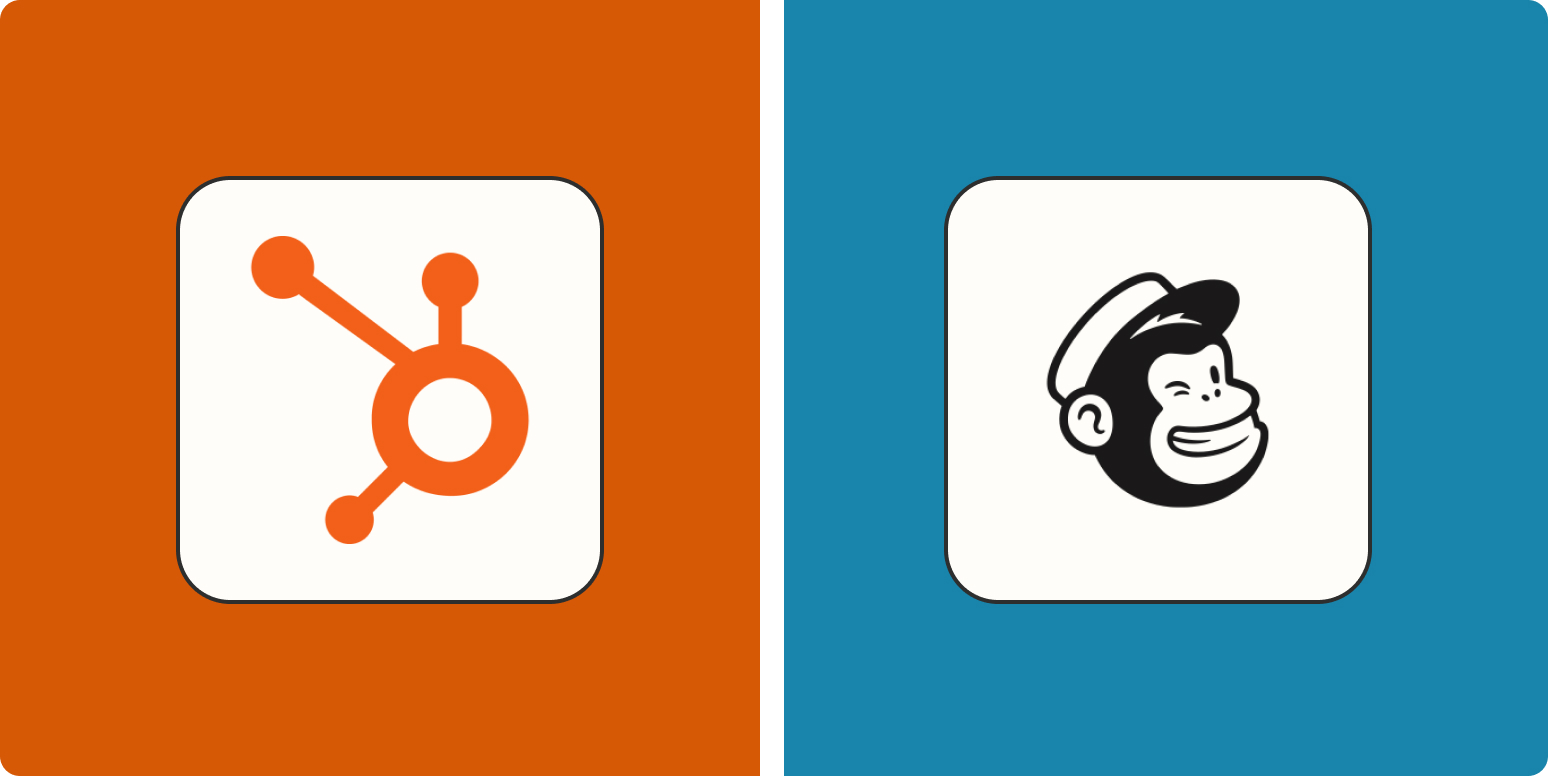For most of my career, I’ve used HubSpot for marketing simply because the companies I worked for already used that platform when I joined the team. But since going freelance, I’ve been working a lot more with clients who use Mailchimp.
I spent more time in each of the two marketing platforms to better see the differences between the two tools. Based on that experience, and my experience using each of these tools for my work, here’s how they stack up.
HubSpot vs. Mailchimp at a glance
Choosing between HubSpot and Mailchimp as your marketing platform depends on a few core factors:
In the end, these are completely different tools with completely different goals. Mailchimp is purely marketing software, whereas HubSpot is an all-in-one tool that can (if you want) combine marketing, sales, content management, operations, and customer service onto one platform. For that reason, HubSpot is built to do a lot more than what Mailchimp can do.
If you want a tool that can do your marketing, sales, customer service, and operations, then you shouldn’t be comparing HubSpot to Mailchimp at all—instead, you’ll want to compare HubSpot with Salesforce or a similar all-in-one tool.
Here, I’ll focus on comparing the parts where Mailchimp and HubSpot overlap. In practice, this means comparing Mailchimp’s full offering with HubSpot’s Marketing Hub package, focusing mainly on email marketing, marketing automation, landing pages, and reports and analytics.
|
HubSpot |
Mailchimp |
|
|---|---|---|
|
Cost |
⭐⭐⭐⭐ Solid free plan; paid plans are more expensive (and not super straightforward), but it can be cost-effective if you plan to use all the features available |
⭐⭐⭐⭐ Robust free plan and simple pricing system that comes in three tiers |
|
Ease of use |
⭐⭐⭐ A steeper learning curve for new users because it’s an all-in-one tool |
⭐⭐⭐⭐ Comparatively beginner-friendly |
|
Contact and email limits |
⭐⭐⭐⭐ Unlimited contacts for free, but you’re limited to 2,000 sends per month on free plan; on paid accounts, email send limits are based on number of contacts you’re paying for (5x on Starter and 10x on Pro) |
⭐⭐⭐⭐ 2,500 sends per month on free account for up to 500 marketing contacts (5k on Essentials, 6k on Standard); email sends (and price) go up incrementally depending on the number of marketing contacts you have |
|
Landing pages |
⭐⭐⭐⭐ 20 free landing pages on the free plan; more customizable; A/B testing available on the Professional plan |
⭐⭐⭐ Unlimited landing pages on the free plan, but there are more limitations and no A/B testing available |
|
Automation |
⭐⭐⭐⭐⭐ Very advanced automations available |
⭐⭐ Basic automation; impressive for an email marketing tool, but doesn’t compare to HubSpot |
|
Email templates / design |
⭐⭐⭐⭐ 45 templates; very customizable |
⭐⭐⭐⭐ 100 templates; less customizable |
|
Analytics |
⭐⭐⭐⭐⭐ 30 reports free; goes up to 750 reports on Pro plan; deep and valuable metrics |
⭐⭐⭐ Very basic on free plan and not as insightful as HubSpot even on the most expensive plan |
|
Social media |
⭐⭐⭐⭐ Advanced scheduling, publishing, and analytics, but only available on Pro or higher tier |
⭐⭐ Basic options; available only on Standard and higher plans; can only schedule 2 hours in advance |
|
Integrations |
⭐⭐⭐⭐⭐ 1,000+ native integrations; also integrates with Zapier |
⭐⭐⭐⭐ 200+; also integrates with Zapier |
HubSpot’s sophisticated marketing automation caters better to longer buyer lifecycles
Based on my experience using both HubSpot and Mailchimp, I’d say it’s the automation features that really set the two tools apart. When it comes down to it, HubSpot’s automations are just a lot more advanced than Mailchimp’s.
This is primarily because HubSpot is built with a different end-goal in mind. HubSpot is an all-in-one tool that caters to larger businesses with sales teams. As an inbound marketing tool, it allows you to use sophisticated automation workflows to nurture contacts through longer buyer lifecycles (check out a few of my favorite HubSpot workflows). These workflows allow you to trigger automated email sequences that nurture contacts down the marketing funnel and allow you to segment your audience based on their behavior, lead scoring, and what stage they are in the buyer lifecycle.
Here’s an example of what a HubSpot’s workflow looks like:
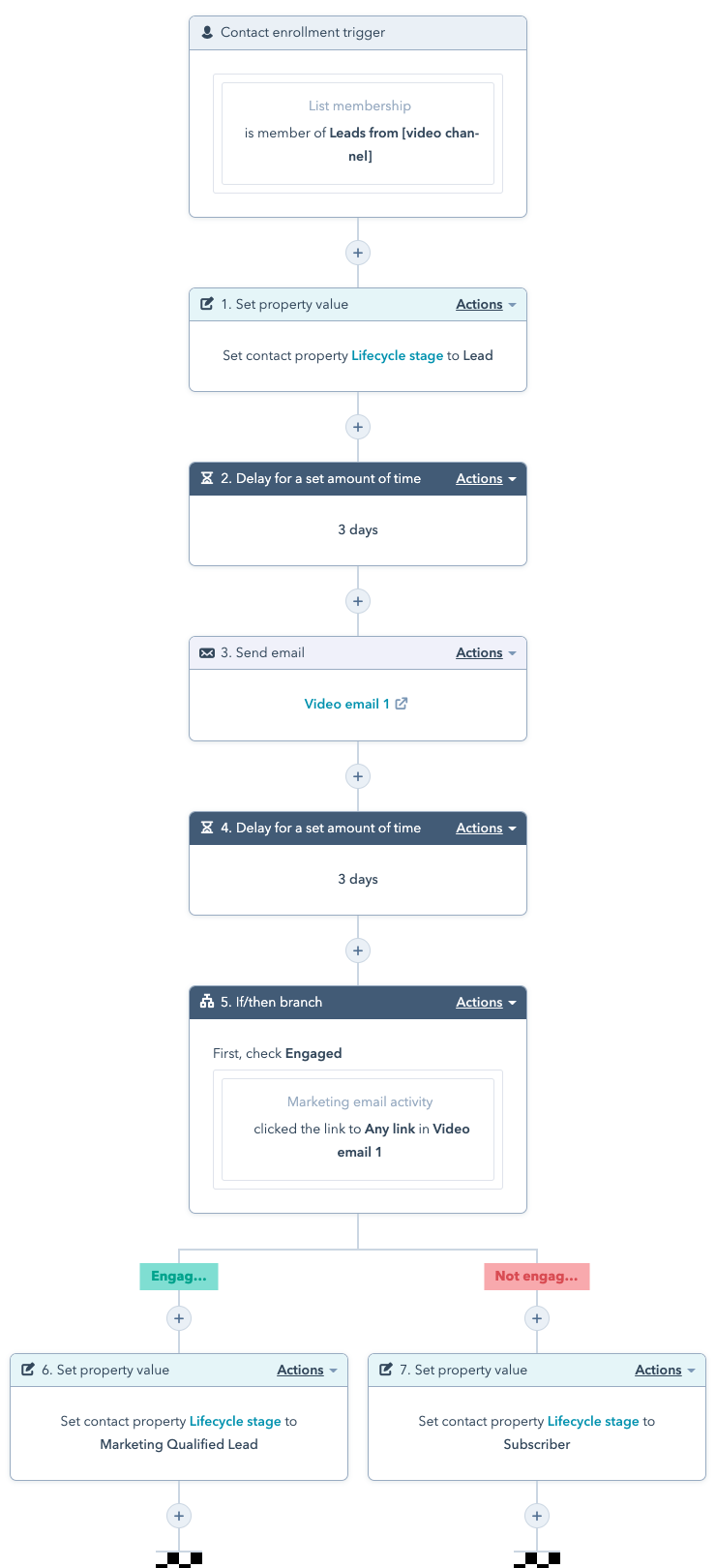
While Mailchimp’s automation is pretty advanced for an email marketing tool, it’s much more basic compared to HubSpot. Even on the free plan, you can set up autoresponder emails that trigger when someone fills out a form or makes a purchase on your website, and on the Essentials and Standard plans, you get access to a customer journey builder that allows you to create basic workflows based on customer behaviors (e.g., when they sign up to make a purchase, they’re tagged as a “New customer” and sent a welcome email).
Here’s an example of what an automation workflow looks like on Mailchimp:

If you’re a business that has a short buyer cycle (e.g., a customer can land on your website for the first time and might make a purchase on the same day), this is all the automation you’re likely to need. But if your customers tend to take longer to make a purchase (maybe they’d want to speak to a salesperson because it involves more money or commitment), then a tool like HubSpot will better support your needs.
Building and sending an email in Mailchimp is simpler
Both Mailchimp and HubSpot offer excellent email builders that are easy to use and intuitive, even for someone with no design or marketing experience. You can easily add elements like text boxes, images, videos, and social buttons just by dragging them into your email from the sidebar menu (or right in the email itself with Mailchimp’s new builder). It’s also easy to move your different elements around the page, select the colors you want, and add images and logos to get your emails looking on-brand.
To show you how similar they are, here’s Mailchimp’s classic editor:
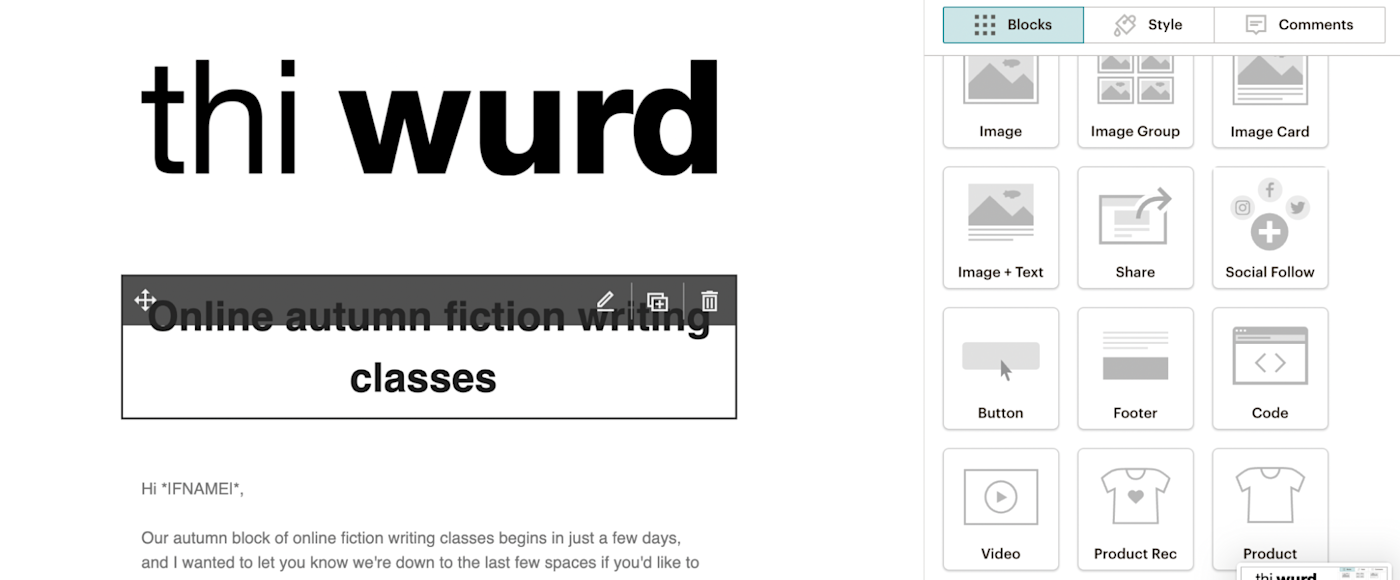
And here’s HubSpot’s:
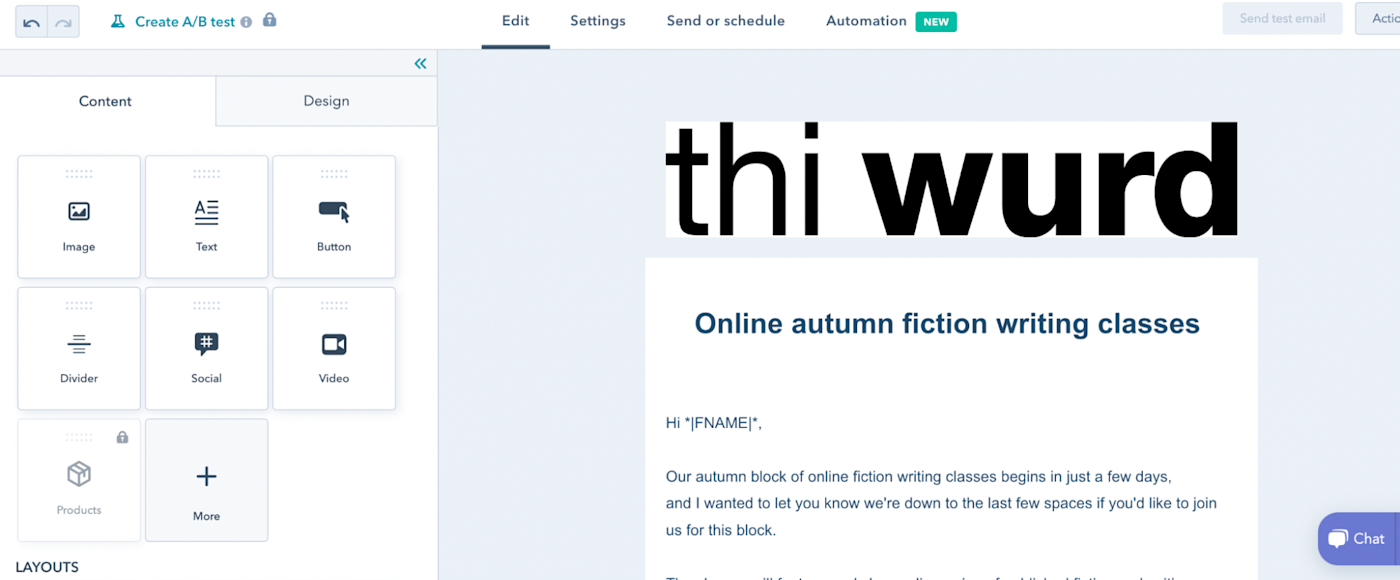
If you’re a bit more confident with email design, you can choose to build your own emails, but both tools have a decent selection of slick out-of-the-box templates. Having said that, Mailchimp comes with double the number of templates HubSpot has (100 designs compared to 45 in HubSpot), which makes it stand out as the quick-and-easy option if you’re less confident with designing your own emails.
When it comes to actually sending your emails, you don’t have to think too hard with Mailchimp. Because HubSpot’s email tool is deeply integrated with a CRM, there are a lot more fields to check through before you hit the Send button, which leaves a bit more room for human error. Even after using HubSpot for years, I still get that sense of trepidation that I might have missed something each time I send an email because there’s so much to think about. You don’t get that feeling sending emails through Mailchimp.
HubSpot offers more advanced analytics
For any marketing tool to do its job of supporting your marketing strategy, it needs to provide analytics that you can learn from. Both HubSpot and Mailchimp offer reporting features that provide metrics on everything you can do with each tool.
Naturally, HubSpot’s analytics features are more advanced than Mailchimp’s, because as a tool, it’s built to do more. You get 30 reports on HubSpot’s free plan, and it goes up to 750 on the Professional package. When I ran a marketing team, we structured all our meetings around HubSpot dashboards because the data they provided was so valuable and easy to customize to our needs.

Mailchimp’s analytics offering is a lot more basic in comparison, but if you’re only using reporting to understand how people are engaging with your email marketing, it gets the job done. You can review the stats of individual emails on the free plan (for example, opens, clicks, and unsubscribes), and if you upgrade to Standard or higher, you get a wider overview that allows you to compare your campaign data.
Since using Mailchimp, I’ve noticed that the reports lack the kind of detail that really helps you define and optimize your strategy: it can feel a bit like “ok, but what do I do with this information?”
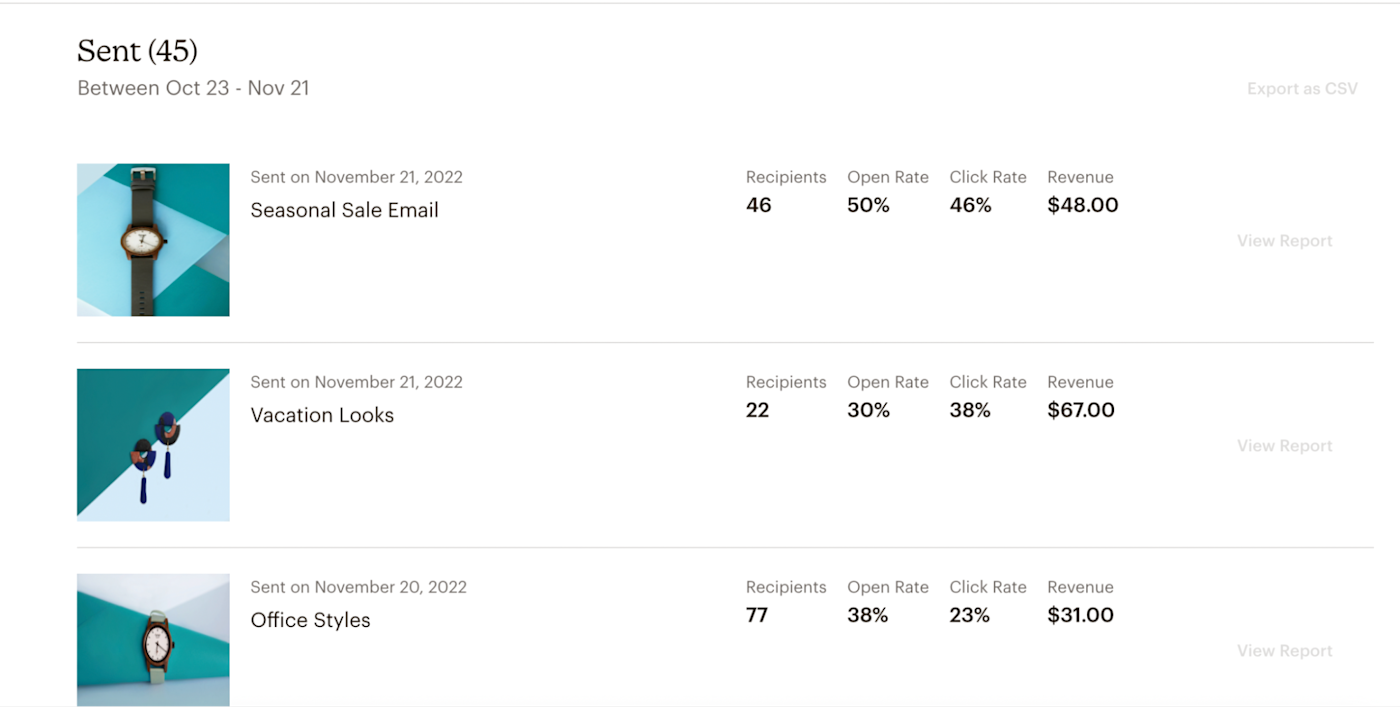
Mailchimp is easier to set up
Considering everything I’ve covered so far about these two tools, it won’t surprise you that Mailchimp is easier to set up than HubSpot. Since HubSpot is a more complex tool that offers a whole load of different features, it takes a bit more consideration to embed it into a business.
It’s not uncommon for companies to hire external HubSpot consultants to manage the setup process for them. In fact, there are entire agencies that focus exclusively on providing HubSpot assistance—they even list out their top HubSpot solutions partners on their website.
Mailchimp solution partners aren’t a thing because the tool isn’t complex enough to require it. The setup process with Mailchimp is quick and straightforward—you could be set up and using the tool in less than an hour.
One example of the contrast in setup is importing contacts. In Mailchimp, it’s really easy to do because the fields are all extremely basic: all you can include in your CSV is the contact’s first name, last name, and email address. When doing the same in HubSpot, it’s a more complicated process. Because HubSpot is also a CRM, every contact you upload will be stored with its own contact record. These contact records have a whole load of fields that help growth teams build a picture of who the contact is and how warm they are as a lead. It’s pretty advanced, and this makes importing contacts a bit more trick—you have to spend a decent amount of time preparing your CSV before you import it into HubSpot.
HubSpot landing pages are more customizable
Both HubSpot and Mailchimp offer functional, well-designed landing pages for capturing leads, but you can do a bit more with landing pages on a HubSpot package.
While Mailchimp offers an unlimited number of landing pages, you only have 10 template designs to choose from, and they don’t offer much wiggle room for customization. If you do customize a landing page to make it more unique to your brand, you can’t save it as a new template for future use.
You’re limited to 20 landing pages on the HubSpot free plan, but realistically, you’re not likely to ever hit that limit on a budget-free marketing strategy anyway. HubSpot offers 20 landing page template designs and they’re more customizable, with custom HTML. You can also A/B test HubSpot landing pages and save CTA buttons, neither of which you can do with Mailchimp’s landing page builder.
Mailchimp is more affordable for email marketing
Both Mailchimp and HubSpot have pretty generous free plans:
-
Mailchimp gives you 500 contacts and 2,500 email sends a month.
-
HubSpot gives you unlimited contacts and 2,000 email sends a month—a little more flexibility, but a little less on actual email sends.
Once you do move to a paid plan, Mailchimp is the cheaper option. With three tiered options that go up incrementally depending on how many contacts you have, Mailchimp’s simple pricing structure is really one of its strengths. HubSpot also has three tiers for its paid marketing plans, but they work out to be more expensive because they offer more features. HubSpot does offer customizable bundles in an attempt to make the tool more affordable, but it still gets very expensive pretty quickly.
For example, if you had 1,500 contacts, you could send 30,000 emails a month for $59/month on Mailchimp’s Starter plan. On HubSpot’s Starter plan, that same number of contacts would cost you $90/month, and you’d only be able to send 7,500 emails (5x the number of contacts).
If you’re at a larger org and budget isn’t an issue for you, HubSpot for sure has more to offer and will scale with your teams. But if you’re a small business looking to build your top-of-funnel marketing contacts, Mailchimp probably does everything you’re likely to need it to do.
You can automate both tools with Zapier
Both HubSpot and Mailchimp integrate with Zapier, so you can connect them with thousands of other apps to automate your mission-critical workflows. Here are some ideas to get you started:
Zapier is the leader in no-code automation—integrating with 5,000+ apps from partners like Google, Salesforce, and Microsoft. Build secure, automated systems for your business-critical workflows across your organization’s technology stack. Learn more.
Mailchimp vs. HubSpot: Which should you choose?
With all this in mind, choosing between Mailchimp and HubSpot should be pretty straightforward once you understand your needs:
Mailchimp will be the right marketing platform for you if:
-
You need a tool that’s simple and easy to use (even for beginners)
-
Your main focus is email marketing and community building
-
Your business model relies on shorter buyer lifecycles
HubSpot will be the right marketing platform for you if:
-
You have more marketing budget to play with
-
You have experienced marketers running your campaigns
-
You have a longer and slower buyer lifecycle that involves a sales team
-
You’re planning for substantial growth
Related reading:
[adsanity_group align=’alignnone’ num_ads=1 num_columns=1 group_ids=’15192′]
Need Any Technology Assistance? Call Pursho @ 0731-6725516

